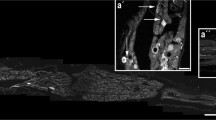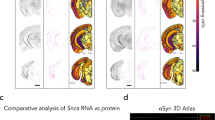Abstract
The substantia nigra cells of a normal and Parkinson’s disease human brain were obtained by the micropunch procedure and total RNA was isolated. Differential display RT-PCR of the total RNA revealed differentially expressed cDNAs that were identified by sequencing. This resulted in the identification of a panel of known and unknown differentially expressed genes. Complex I (NADH ubiquinone oxidoreductase) and Complex IV (cytochrome oxidase) whose expressions are decreased in Parkinson’s disease were reduced in the Parkinson brain. Of the various differentially expressed genes, flotillin-1, also known as reggie-2, was of great interest to us. It is a relatively new protein which is an integral membrane component of lipid rafts and has been implicated in signal transduction pathway events. In situ hybridization histochemical studies with human and rat brain sections revealed the presence of this mRNA in discrete neuronal (and possibly glial) cells of the substantia nigra, locus coeruleus, cortex, hippocampus, hypothalamus, thalamus, motor nuclei, nucleus basalis, raphe nucleus, and other brain regions. Immunohistochemical studies revealed that flotillin-1 is not present in all the regions where the message was found. In the rat brain, the most prominent observation was the revelation of all cate-cholamine cells (dopamine, norepinephrine, epinephrine) by the flotillin-1 antibody (1:100 dilution). At a more concentrated dilution (1:10) other neuronal cells (e.g., cortex, thalamus, hindbrain) were observed. At both dilutions dense dopaminergic fibers were observed in the rat caudate-putamen, nigrostriatal tract, and substantia nigra. It is significant that there is an increased gene expression of flotillin-1 in the Parkinson substantia nigra/ventral tegmental area. The role of flotillin in these cells is unclear although it is interesting that the reggie-2/flotillin-1 gene was upregulated during retinal axon regeneration in the goldfish visual pathway (Schulteet al., Development 124:577–87, 1997) which suggests that flotillin-1/reggie-2 might play a role in axonal growth from the remaining substantia nigra cells of the Parkinson brain.
Similar content being viewed by others
Abbreviations
- DTT:
-
dithiothreitol
- GAPDH:
-
Glyceraldehyde-3-phos-phate dehydrogenase
- GFAP:
-
glial fibrillary acidic protein
- ISHH:
-
in situ hybridization histochemistry
- SNC:
-
substantia nigra compacta
- SSC:
-
saline-sodium citrate
- VTA:
-
ventral tegmental area
References
Bankiewicz KS, RJ Plunkett, IJ Kopin, DM Jacobowitz, U di Porzio, WT London and EH Olfield (1990) Recovery from MPTP-induced parkinsonism in primates after fetal dopaminergic brain implants: histochemical and behavioral studies.Histochemistry 93, 519–523.
Bauer SH, MF Wiechers, K Bruns, M Prybylski and CA Stuermer (2001) Isolation and identification of the plasma membrane-associated intracellular protein reggie-2 from goldfish brain by chro-matography and Fourier-transform ion cyclotron resonance mass spectrometry.Anal. Biochem. 298, 25–31.
Baumann A, V Ribon, M Kanzaki, DC Thurmond, S Mora, S Shigematsu, PE Bickel, JE Pessin and AR Saltiel (2000) CAP defines a second signaling pathway required for insulin-stimulated glucose transport.Nature 407, 202–207.
Bickel PE, PE Scherer, JE Schnitzer, PM Oh, P Lisanti and HF Lodish (1997) Flotillin and epidermal surface antigen define a new family of caveole-associated integral membrane proteins.J. Biol. Chem. 272, 19793–19802.
Bing G, Y Zhang, Y Watanabe, B McEwen and E Stone (1994) Locus coeruleus lesions potentiate neurotoxic effects of MPTP in dopaminergic neurons of the substantia nigra.Brain Res. 668, 261–265.
Björklund A and A Nobin (1973) Fluorescence histochemical and microspectrofluorometric mapping of dopamine and noradrena-line cell groups in the rat diencephalons.Brain Res. 51, 193–205.
Dahlström A and K Fuxe (1964) Existence of monoamine containing neurons in the cell bodies of brain stem neurons.Acta Physiol. Scand. 232, 1–53.
Fantini J, N Garmy, R Mahfoud and N Yahi (2002) Lipid rafts: structure, function and role in HIV, Alzheimer’s and prion diseases.Expert Rev. Mol. Med.: http://www.expertreviews.org/.
Foltynie T, S Sawcer, C Brayne and RA Barker (2002) The genetic basis of Parkinson’s Disease.J. Neurol. Neurosurg. Psychiatry 73, 363–370.
Fuxe K (1965) Evidence for the existence of monoamine neurons in the central nervous system. IV. Distribution of monoamine nerve terminals in the central nervous system.Acta Physiol. Scand. 247, 38–85.
Galbiati F, V Daniela, JS Goltz, Z Steele, J Sen, J Jurcsak, D Stein, L Steven and MP Lisanti (1998) Identification, sequence and developmental expression of invertebrate flotillins from Drosophila melanogaster.Gene 210, 229–237.
Gwinn-Hardy K (2002) Genetics of parkinsonism.Mov. Disord. 17, 645–656.
Hökfelt T, R Märtensson, A Björklund, S Kleinan and M Goldstein (1984) Distributional maps of tyrosine-hydroxylase-immunoreac-tive neurons in the rat brain, InHandbook of Chemical Neuroanatomy, Vol. 2: Classical Transmitters in the CNS, Part I (Björklund A and T Hökfelt, Eds.) (Elsevier: New York, NY), pp 277–379.
Hornykiewicz O (1996) Dopamine (3-hydroxytryptamine) and brain function.Parmacol. Rev. 18, 925–963.
Jacobowitz DM (1974) Removal of discrete fresh regions of the rat brain.Brain Res. 80, 111–115.
Jacobowitz DM and M Palkovits (1974) Topographic atlas of cate-cholamine and acetylcholinesterase-containing neurons in the rat brain. I. Forebrain (telencephalon, diencephalon).J. Comp. Neurol. 157, 13–28.
Jellinger K (1991) Pathology of Parkinson’s disease: changes other than the nigrostriatal Pathway.Mol. Chem. Neuropathol. 14, 153–197.
Kokubo H, CA Lemere and H Yamaguchi (2000) Localization of flotillins in human brain and their accumulation with the progression of Alzheimer’s disease pathology.Neurosci. Lett. 290, 93–96.
Kostrzewa RM and DM Jacobowitz (1974) Pharmacological actions of 6-hydroxydopamine.Pharmacol. Rev. 26, 199–288.
Lang DM, S Lommel, M Jung, R Ankerhold, B Petrausch, U Laessing, MF Wiechers, H Plattner and CAO Stuermer (1998) Fast track identification of reggie-1 and reggie-2 as plasma membrane-associated proteins which cocluster with activated GPI-anchored cell adhesion molecules in non-caveolar micropatches in neurons.J. Neurobiol. 37, 502–523.
Langston JW (2002) Parkinson’s disease: current and future challenges.Neurotoxicology 23, 443–450.
Liang P and AB Pardee (1995) Recent advances in differential display.Curr. Opin. Immunol. 7, 274–280.
Malaga-Trillo E, U Laessing, DM Lang, A Meyer and CA Stuermer (2002) Evolution of duplicated reggie genes in zebrafish and goldfish.J. Mol. Evol. 54, 235–245.
Mavridis M, AD Degryse, AJ Lategan, MR Marien and FC Colpaert (1991) Effects of locus coeruleus lesions on parkinsonian signs, striatal dopamine and substantia nigra cell loss after 1-methyl-4-phenyl-1,2,3,6-tetrahydropyridine in monkeys.Neuroscience 41, 507–523.
Palkovits M (1973) Isolated removal of hypothalamic or other brain nuclei of the rat.Brain Res. 59, 449–450.
Palkovits M and DM Jacobowitz (1974) Topographic atlas of cate-cholamine and acetylcholinesterase-containing neurons in the rat brain. II. Hindbrain (mesencephalon, rhombencephalon).J. Comp. Neurol. 157, 29–42.
Paxinos G and C Watson (1986)The Rat Brain in Stereotaxic Coordinates (Academic Press: New York, NY).
Petrausch B, R Tabibiazar, T Roser, Y Jing, D Goldman, CA Stuermer, N Irwin and LI Benowitz (2000) A purine-sensitive pathway regulates multiple genes involved in axon regeneration in goldfish retinal ganglion cells.J. Neurosci. 20, 8031–8041.
Pycock CJ, IM Donaldson and CD Marsden (1975) Circling behaviour produced by unilateral lesions in the region of the locus coeruleus in rats.Brain Res. 97, 317–329.
Salzer U and R Prohaska (2001) Stomatin, flotillin-1 and flotillin-2 are major integral proteins of erythrocytes lipid rafts.Blood 97, 1141–1143.
Schapira AH (1994) Evidence for mitochondrial dysfunction in Parkinson’s disease-a critical appraisal.Mov. Disord. 9, 125–138.
Schroeder W, S Stewart-Galetka, DA Parry, D Goldsmith and ML Duvic (1994) Cloning and characterization of a novel epidermal cell surface antigen (ESA).J. Biol. Chem. 269, 19983–19991.
Schulte T, KA Paschke, U Laessing, F Lottspeich and CAO Stuermer (1997) Reggie-1 and reggie-2, two cell surface proteins expressed by retinal ganglion cells during axon regeneration.Development 124, 577–587.
Stuermer CAO, DM Lang, F Kirsch, M Wiechers, SO Deininger and H Plattner (2001) Glycosylphosphatidyl inositol-anchored proteins and fyn kinase assemble in noncaveolar plasma membrane microdomains defined by reggie-1 and reggie-2.Mol. Biol. Cell 12, 3031–3045.
Suzuki T (2002) Lipid rafts at postsynaptic sites: distribution, function and linkage to postsynaptic density.Neurosci. Res. 44, 1–9.
Volonte D, F Galbiati, S Li, K Nishiyama, T Okamoto and MP Lisanti (1999) Flotillins/cavatellins are differentially expressed in cells and tissues and form a hetero-oligomeric complex with cave-olinsin vivo: characterization and epitope-mapping of a novel flotillin-1 monoclonal antibody probe.J. Biol. Chem. 274, 12702–12709.
Weinstock M, AP Zavadil, EA Muth, WR Crowley, TL O’Donohue, DM Jacobowitz and IJ Kopin (1980) Evidence that noradrenaline modulates the increase in striatal dopamine metabolism induced by muscarinic receptor stimulation.Eur. J. Pharm. 68, 427–435.
Zarow C, SA Lyness, JA Mortimer and HC Chui (2003) Neuronal loss is greater in the locus coeruleus than nucleus basalis and sub-stantia nigra in Alzheimer and Parkinson diseases.Arch. Neurol. 60, 337–341.
Author information
Authors and Affiliations
Corresponding author
Rights and permissions
About this article
Cite this article
Jacobowitz, D.M., Kallarakal, A.T. Flotillin-1 in the substantia Nigra of the Parkinson brain and a predominant localization in catecholaminergic nerves in the rat brain. neurotox res 6, 245–257 (2004). https://doi.org/10.1007/BF03033435
Received:
Revised:
Issue Date:
DOI: https://doi.org/10.1007/BF03033435




